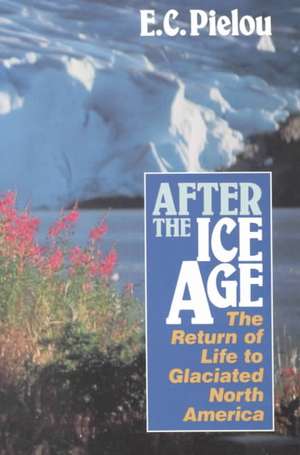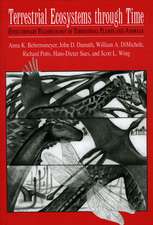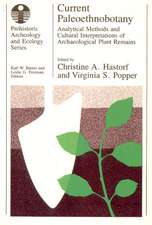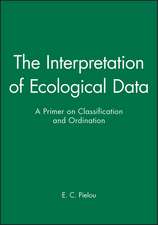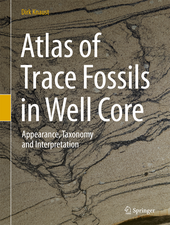After the Ice Age: The Return of Life to Glaciated North America
Autor E. C. Pielouen Limba Engleză Paperback – dec 1992
The fascinating story of how a harsh terrain that resembled modern Antarctica has been transformed gradually into the forests, grasslands, and wetlands we know today.
"One of the best scientific books published in the last ten years."—Ottowa Journal
"A valuable new synthesis of facts and ideas about climate, geography, and life during the past 20,000 years. More important, the book conveys an intimate appreciation of the rich variety of nature through time."—S. David Webb,Science
"One of the best scientific books published in the last ten years."—Ottowa Journal
"A valuable new synthesis of facts and ideas about climate, geography, and life during the past 20,000 years. More important, the book conveys an intimate appreciation of the rich variety of nature through time."—S. David Webb,Science
Preț: 169.42 lei
Nou
Puncte Express: 254
Preț estimativ în valută:
32.42€ • 33.72$ • 26.77£
32.42€ • 33.72$ • 26.77£
Carte disponibilă
Livrare economică 24 martie-07 aprilie
Preluare comenzi: 021 569.72.76
Specificații
ISBN-13: 9780226668123
ISBN-10: 0226668126
Pagini: 376
Ilustrații: 259 line drawings, maps, and diagrams
Dimensiuni: 152 x 229 x 30 mm
Greutate: 0.5 kg
Ediția:1
Editura: University of Chicago Press
Colecția University of Chicago Press
ISBN-10: 0226668126
Pagini: 376
Ilustrații: 259 line drawings, maps, and diagrams
Dimensiuni: 152 x 229 x 30 mm
Greutate: 0.5 kg
Ediția:1
Editura: University of Chicago Press
Colecția University of Chicago Press
Cuprins
Part One: Preliminaries
1. The Physical Setting
The Changing Climate of the Last 20,000 Years
The Dating Method
The Ice Sheets
Ice and Sea
Ice and Fresh Water
Ice and Atmosphere
Ice-free Land: Refugia and Nunataks
2. The Fossil Evidence
Fossils
Microfossils
Pollen
Sediment Cores and Pollen Diagrams
Dating: The Radiocarbon Method
Dating by Volcanic Ash Layers
3. Interpreting the Evidence
Some of the Problems
Interpreting Pollen Diagrams
Interpreting Geographical Range Maps: Animals
Interpreting Geographical Range Maps: Plants
4. The Migration of Vegetation
Shifting Zones of Vegetation
The Starting Conditions
Conditions in the Newly Deglaciated Land
The Invasion by Plants
The Renewal of Vegetation
Ecological Inertia
Photoperiodism
Part Two: The Time of Maximum Ice
5. Eighteen Thousand Years Ago: Life South of the Ice
Large Mammals and Their Environments South of the Ice Sheets
Human Life South of the Ice
Plants South of the Ice Sheets
6. The Coasts
North America as an Extension of Asia
The South Coast of Beringia
The Western Edge of the Ice
The East Coast Plains and Islands
The East Coast Refugia
7. Beringia and the Ice-free Corridor
Beringia and Its Big Game
Human Life in Beringia
The Ice-free Corridor
Refugia Near the Ice-free Corridor
Part Three: The Melting of the Ice
8. The Ice Begins to Melt
South of the Ice: Tundra
South of the Ice: Forest Parkland and Muskeg
Stagnant Ice
Superglacial and Ice-walled Lakes and Their Ecology
9. The Great Proglacial Lakes
Glacial Lakes Missoula and Columbia
Migration from Bergingia
Glacial Lakes Agassiz and McConnell
The Precursors of the Great Lakes and Glacial Lake Ojibway
10. The Rising Sea
The Sundering of Beringia
The Atlantic Shore
The Atlantic Coastlands
The champlain Sea
The Tyrell Sea
Part Four: The Pleistocene/Holocene Transition
11. The End of an Epoch
The End of the Pleistocene
The Changing Forest
The Prairie Grasslands
Transition in the West: The Interior
Transition in the West: The Coast
Beringia at the Turn of the Epoch
12. The Great Wave of Extinctions
Extinction Waves: When, Where, and What
The Prehistoric Overkill Hypothesis
The Arguments against Overkill
Changing Environment Theories
Extinct Birds
Part Five: Our Present Epoch, The Holocene
13. The Great Warmth
Some Northward Shifts of Northern Limits
The Hypsithermal at Sea
The Hypsithermal in the Mountains
Refugia from the Drought
Human Life in the Hypsithermal
14. The Neoglaciation
The Spread of Muskeg
Increased Rain in the Prairies
The Shifting Ranges of Forest Tree Species
The Neoglacial and the Northern Treeline
Refugia Reestablished
Respites in the Neoglaciation
The Little Ice Age
Epilogue
Appendix 1: Names of Species: English and Latin
Appendix 2: Names of Species: Latin and English
Notes
Index
1. The Physical Setting
The Changing Climate of the Last 20,000 Years
The Dating Method
The Ice Sheets
Ice and Sea
Ice and Fresh Water
Ice and Atmosphere
Ice-free Land: Refugia and Nunataks
2. The Fossil Evidence
Fossils
Microfossils
Pollen
Sediment Cores and Pollen Diagrams
Dating: The Radiocarbon Method
Dating by Volcanic Ash Layers
3. Interpreting the Evidence
Some of the Problems
Interpreting Pollen Diagrams
Interpreting Geographical Range Maps: Animals
Interpreting Geographical Range Maps: Plants
4. The Migration of Vegetation
Shifting Zones of Vegetation
The Starting Conditions
Conditions in the Newly Deglaciated Land
The Invasion by Plants
The Renewal of Vegetation
Ecological Inertia
Photoperiodism
Part Two: The Time of Maximum Ice
5. Eighteen Thousand Years Ago: Life South of the Ice
Large Mammals and Their Environments South of the Ice Sheets
Human Life South of the Ice
Plants South of the Ice Sheets
6. The Coasts
North America as an Extension of Asia
The South Coast of Beringia
The Western Edge of the Ice
The East Coast Plains and Islands
The East Coast Refugia
7. Beringia and the Ice-free Corridor
Beringia and Its Big Game
Human Life in Beringia
The Ice-free Corridor
Refugia Near the Ice-free Corridor
Part Three: The Melting of the Ice
8. The Ice Begins to Melt
South of the Ice: Tundra
South of the Ice: Forest Parkland and Muskeg
Stagnant Ice
Superglacial and Ice-walled Lakes and Their Ecology
9. The Great Proglacial Lakes
Glacial Lakes Missoula and Columbia
Migration from Bergingia
Glacial Lakes Agassiz and McConnell
The Precursors of the Great Lakes and Glacial Lake Ojibway
10. The Rising Sea
The Sundering of Beringia
The Atlantic Shore
The Atlantic Coastlands
The champlain Sea
The Tyrell Sea
Part Four: The Pleistocene/Holocene Transition
11. The End of an Epoch
The End of the Pleistocene
The Changing Forest
The Prairie Grasslands
Transition in the West: The Interior
Transition in the West: The Coast
Beringia at the Turn of the Epoch
12. The Great Wave of Extinctions
Extinction Waves: When, Where, and What
The Prehistoric Overkill Hypothesis
The Arguments against Overkill
Changing Environment Theories
Extinct Birds
Part Five: Our Present Epoch, The Holocene
13. The Great Warmth
Some Northward Shifts of Northern Limits
The Hypsithermal at Sea
The Hypsithermal in the Mountains
Refugia from the Drought
Human Life in the Hypsithermal
14. The Neoglaciation
The Spread of Muskeg
Increased Rain in the Prairies
The Shifting Ranges of Forest Tree Species
The Neoglacial and the Northern Treeline
Refugia Reestablished
Respites in the Neoglaciation
The Little Ice Age
Epilogue
Appendix 1: Names of Species: English and Latin
Appendix 2: Names of Species: Latin and English
Notes
Index
